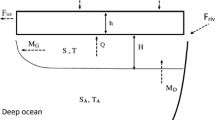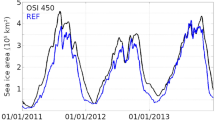Abstract
A coupled ocean-sea ice-atmosphere model is used to study interdecadal variability (∼40 years) of sea ice depth and concentration in the Greenland-Iceland-Norwegian Sea. This oceanic region is represented by a meridionally aligned channel on a β-plane with open zonal boundaries at 60 °N and 80 °N. The model consists of a one and a half layer reduced gravity ocean model, a thermodynamic/dynamic sea ice model and an energy balance model of the atmosphere. The coupled model is driven by prescribed surface wind stress, fluxes of heat, salt and ice at inflow points on the northern and southern open zonal boundaries and annual distribution of solar radiation. It is shown that the coupled model supports unforced modes of interdecadal oscillation resulting from a form of hydraulic control which regulates the total fluid volume in the oceanic active layer. The mechanism for the oscillations relies on the presence of three key features: (1) a region of intense oceanic entrainment located in the eastern part of the domain, (2) a vigorous southward flowing western boundary current, representing the East Greenland Current (EGC), which supports most of the meridional transport across the domain, and (3) a marked buoyancy contrast between the relatively salty domain interior and the much fresher western boundary region. During an oscillation excess water is pumped into the domain via entrainment, thereby creating an active layer depth anomaly, which then propagates westward via long baroclinic Rossby waves until it reaches the EGC where it is subsequently drained out of the domain across the southern open zonal boundary. As the depth anomaly traverses the basin, an anomalous geostrophic circulation is established in which cold fresh Arctic water enters the domain interior, and this eventually promotes enhanced thermodynamic sea ice growth. Consequently, the interdecadal oscillations of the coupled model are characterised by pulse periods, typically spanning 20 years, during which there is an abnormally large winter sea ice cover, separated by interpulse periods, lasting another 20 years, during which the winter sea ice extent is nearly uniform and significantly smaller than in a pulse maximum. The duration of the interpulse periods is dictated by the time it takes for the Rossby waves to traverse the basin. In addition to the interdecadal oscillation solution, the coupled ocean-sea ice-atmosphere model is found to also have a stable cyclostationary state, with no interannual variability. Stochastic forcing, in the form of randomly specified interannual anomalies of salinity (of maximum amplitude 0.1 ppt) or ice inflow (of maximum amplitude 0.1 Sv) at the northern open zonal boundary, in both cases is capable of driving the model from the cyclostationary state solution to the interdecadal variability one.
Similar content being viewed by others
Author information
Authors and Affiliations
Additional information
Received: 16 August 1996 / Accepted: 27 July 1998
Rights and permissions
About this article
Cite this article
Morales-Maqueda, M., Willmott, A. & Darby, M. A numerical model for interdecadal variability of sea ice cover in the Greenland-Iceland-Norwegian Sea. Climate Dynamics 15, 89–113 (1999). https://doi.org/10.1007/s003820050270
Issue Date:
DOI: https://doi.org/10.1007/s003820050270




